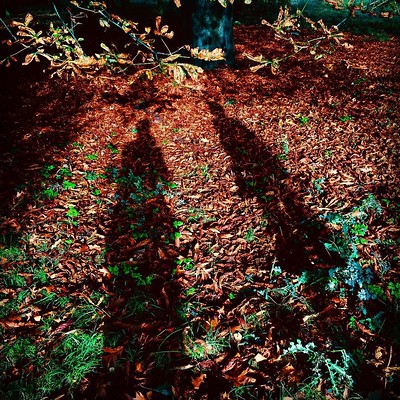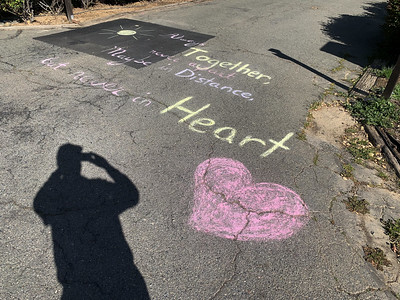The global health crisis has brought my new research project, ‘Concepts and Cultivations of Distance in the Twentieth Century’, uncomfortably close to home. The pandemic throws into relief how spatial, social and emotional experiences of distance intersect, and how these intersections shape our ways of living together. The need for physical distancing has created a need to find new ways to be close to one another: in private relationships, in local communities, in our society.
Visible gestures of generosity, such as volunteers assisting isolated elderly citizens or neighbours picking up supplies for one another, help us feel emotionally connected when direct personal contact is severely restricted.
Yet, counter-intuitively, the current situation may also require us to maintain distance, not just in the physical sense but also in interpersonal and emotional relations. There is a risk of compensating for the current sense of crisis and isolation with too much closeness at both a private and social level. And this too can have problematic consequences.
***
In his 1924 essay The Limits of Community, the philosophical anthropologist Helmuth Plessner suggests that establishing interpersonal distance between individuals is the key for a well-functioning society. At the same time, these distancing practices need to be smoothed over by conventional codes of conduct. Of course, the distance we are currently concerned with is the six feet of physical separation needed to protect ourselves and others from infection. But this bodily experience of apartness has wider implications for our practices of cohabitation.

Everyday now, we have to negotiate new rules for interpersonal interaction: what used to be a gesture of kindness, such as guiding an elderly person through a busy intersection, may now put the same person at risk.
Foregoing the handshake is more polite than offering it.
Crossing over to the other side of the road can now be seen as a sign of respect rather than an expression of animosity. Besides the unease that the pandemic itself inevitably brings, it is this disruption of everyday conventions that brings out feelings of unsettledness and irritability.
As this state of exception threatens to become the new normal, we will require new conduct codes, as Plessner would say, new forms of tact, in order to ease these feelings, to compensate for the new distancing practices, and to make our minimal contact with strangers bearable. And we will also have to think about more distanced or ‘tactful’ ways to communicate, in order to minimize the ‘contagion of fear’.
Fear and isolation do not go well together. When we are feeling anxious about something, the advice is often to find a person we trust and to talk it out. How helpful such a conversation can be, depends in large part on whether the other person is able to meet us in our state of fear. The sociologist Richard Sennett distinguishes here between sympathy and empathy:
while sympathy is eliminating the distance between self and other through an act of identification (‘putting oneself in the other’s shoes’), empathy is a more distanced attitude that is necessary to meet the other person on their own terms.
But when our fear is not tied to individual circumstances, it becomes harder to find listeners able to maintain this right balance between distance and closeness. During the pandemic, most of us will experience varying degrees of fear. It is certainly not helpful to go through these feelings alone. Finding and giving support within our social circles is absolutely vital. But we have to be aware of the fact that fear, just like the virus itself, is extremely contagious.

This is not to make an argument for aseptic relationships. It is, however, a reason to think carefully about how we deal with our own fear and that of others. How do we create conversations that will help one person talk about their fear but won’t leave the other depleted and overcome by fear in turn? The fact that we are all affected by the pandemic can – and does – create new forms of solidarity and connectedness. But it can also lead to the individual and collective experience of being overwhelmed and paralysed by fear. This is dangerous because fear makes us turn inward, focus on what’s close to us, and consumes a large part of our empathic energy.
***
Our feelings of fear and our ability to feel empathy are inextricably linked to the experience of spatial and cultural distance. As the psychologist Paul Bloom has argued in his book Against Empathy (2016), it is far easier to feel empathy for those closest to us and, importantly, for those whom we recognise as more vulnerable and less scary. But who counts as vulnerable, and who is deemed to be scary?
Fear, as Sara Ahmed suggests in her 2004 study The Cultural Politics of Emotions, operates as a cultural-political practice: it establishes distance between individuals who are racially marked as ‘other’ and the proximity relationships within a majority white society. Fear of infection, in particular, has a long history of racially-charged exclusionary distancing practices that also have become apparent in the current pandemic.
From violent verbal and physical attacks on people of Asian descent in many countries to the president of the United States insisting on referring to the coronavirus as ‘the Chinese virus’, we are experiencing how the fear of infection tends to fuel racist language and actions.
Research by those such as historian Philip Sarasin on the politics of infection has shown that viruses were being imagined as ‘evil invaders’ or ‘invisible enemies’, and conflated with entire social and ethnic groups, by the end of the nineteenth century. The idea that pathogens could cross all socially constructed borders and infect individuals from all social classes and ethnic backgrounds did not inspire a politics of equality and solidarity at the time. Rather, the transgressive quality and the invisibility of germs became linked to an imagination of boundaries, of their potential permeability, and of the need to defend them.

In the current media coverage of the pandemic, we encounter once again an increasing use of war metaphors. Of course, the efforts to make citizens comply to governmental guidelines of social distancing and self-isolation are undoubtedly to be supported; and appealing to a sense of community may convince people to accept necessary restrictions of their individual freedom. But militaristic metaphors for the virus tend to merge the individual and the nation, which may increase solidarity within the national community, but inevitably fuels the fear of and aggression toward the ‘foreign other’.
While governments all over the world ask their citizens to show one another kindness and generosity, many nations close their borders and suspend existing programmes for asylum seekers. The fear of contagion and the need to seek comfort in the closeness of the community can therefore become politically exploited in order to legitimize exclusionary distancing practices.
***
Can a focus on our shared vulnerability enforce a more inclusive and less territorial sense of connectedness and solidarity? There is certainly something hopeful about the idea that the virus could make us somehow kinder, more loving, and more connected, especially amidst all the suffering, anxiety, and grief it is creating, and despite the long periods of social distancing and isolation it requires. Of course, there is nothing wrong with focusing on kindness in these challenging times.
At a personal level, connecting with our actual loved ones and building new support networks in our communities will be essential to get us through this crisis. But if we are hoping that the pandemic could bring about a more global sense of solidarity, the ‘power of love’ may not be the answer.
Feeling love beyond our closest relationships is only possible through acts of identification which are likely to take on tribal or even totalitarian forms.
Judith Butler’s recent work is concerned with the formulation of a new ethics based on our interdependency. And perhaps the reversibility of proximity and distance that the pandemic has brought on – ‘elsewhere’ is now ‘here’ – could inform a new ethics and even more crucially a new politics of cohabitation. Significantly, accepting our global interdependence does not mean that we must have the same emotional response to distant strangers that we have to those closest to us.
Butler argues that it is precisely the involuntary nature of our global interdependency that engenders ‘obligations to preserve the lives of those we may not love, those we may never love, do not know, and did not choose’.
Her point is that the constant political denial of this interdependency makes it possible to ignore the ethical obligations that emerge from it. For the current moment, the pandemic has suspended this ongoing denial.
Don’t get me wrong: it is wonderful that we are singing from our balconies, clapping for healthcare professionals, and have our kids paint ‘thank you’ signs for delivery drivers.

However, we have to recognize these gestures as momentary emotional damage control that is not sustainable. After the first shock of this global health crisis, we can take the opportunity to take a step back.
Whether it is the Western colonial arrogance towards China and other countries, harrowing funding cuts and privatization of national health care systems, the obliteration of paid sick leave in many low-income jobs, or neglect and isolation of the elderly – we will be able to recognize the ethical and political failures that the persistent denial of our local and global interdependency has produced and that the pandemic has laid bare.
Marie Kolkenbrock (@M_Kolkenbrock) is a Branco Weiss Fellow in the Department of German at King’s College London.